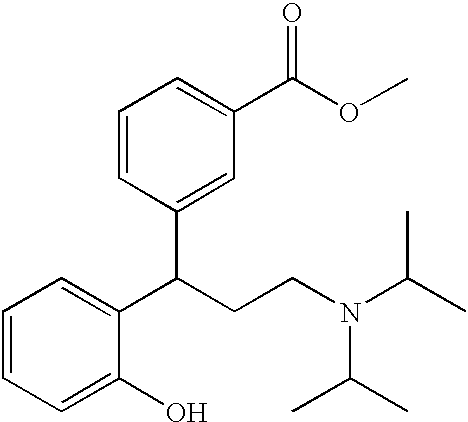Novel anticholinergic compounds and methods of use
a technology of anticholinergic compounds and compounds, applied in the field of new anticholinergic compounds and methods of use, can solve the problems of allergic lid reactions, edema and photophobia, ophthalmic use of these agents may also induce local side effects,
- Summary
- Abstract
- Description
- Claims
- Application Information
AI Technical Summary
Problems solved by technology
Method used
Image
Examples
example 1
m, n, p, and q=0, X is a bond, and R.sub.2 is hydrogen
[0067] 2
Structure II 3-[3-Diisopropylamino-1-(2-hydroxy-phenyl)-propyl]-benzoic acid methyl ester
[0068] Other examples include:
[0069] 3-[1-(2-Hydroxy-phenyl)-3-pyrrolidin-1-yl-propyl]-benzoic acid methyl ester;
[0070] 3-(1-Cyclohexyl-3-diisopropylaminopropyl)-4-hydroxy-benzoic acid methyl ester;
[0071] Carboxymethyl-[3-cyclohexyl-3-(2-hydroxy-5-methyl-phenyl)-propyl]-d-iisopropyl-ammonium;
[0072] Methoxycarbonylmethyl-[3-cyclohexyl-3-(2-hydroxy-5-methyl-phenyl)-p-ropyl]-diisopropyl-ammonium;
[0073] Methoxycarbonylmethyl-[3-(2-hydroxy-5-methyl-phenyl)-3-phenyl-propy-l]-diisopropyl-ammonium; and
[0074] Methoxycarbonylmethyl-[3-(5-acetoxymethyl-2-hydroxy-phenyl)-3-pheny-l-propyl]-diisopropyl-ammonium.
example 2
m, n p, and q=0, X is a bond, and R.sub.2 is hydroxyl
[0075] 3
Structure III. 3-(3-Diisopropylamino-1-hydroxy-1-phenyl-propyl)-benzoic acid
[0076] Other examples include:
[0077] 3-(3-Diisopropylamino-1-hydroxy-1-phenyl-propyl)-benzoic acid methyl ester;
[0078] 3 -Diisopropylamino-1-(3-hydroxymethyl-phenyl)-1-phenyl-propan-1-ol-;
[0079] 3 -Diisopropylamino-1-phenyl-1-m-tolyl-propan-1-ol;
[0080] Carboxymethyl-(3-hydroxy-3-phenyl-3-m-tolyl-propyl)-diisopropyl-amm-onium; and (3-Hydroxy-3-phenyl-3-m-tolyl-propyl)-diisopropyl-methoxycarbon-ylmethyl-ammonium.
example 3
m, n, p, and q=0, X is CH.sub.2, and R.sub.2 is hydroxyl
[0081] 4
Structure IV. 3-(3-Diisopropylamino-1-hydroxymethyl-1-phenyl-propyl)-benzo-ic acid
[0082] Other examples include:
[0083] 3-(3-Diisopropylamino-1-hydroxymethyl-1-phenyl-propyl)-benzoic acid methyl ester;
[0084] 4-Diisopropylamino-2-(3-hydroxymethyl-phenyl)-2-phenyl-butan-1-ol;
[0085] 4-Diisopropylamino-2-phenyl-2-m-tolyl-butan-1-ol;
[0086] Carboxymethyl-(3-hydroxymethyl-3-phenyl-3-m-tolyl-propyl)-diisoprop-yl-ammonium; and
[0087] Methoxycarbonylmethyl-(3-hydroxymethyl-3-phenyl-3-m-tolyl-propyl)-d-iisopropyl-ammonium.
PUM
| Property | Measurement | Unit |
|---|---|---|
| Time | aaaaa | aaaaa |
Abstract
Description
Claims
Application Information
 Login to View More
Login to View More - R&D
- Intellectual Property
- Life Sciences
- Materials
- Tech Scout
- Unparalleled Data Quality
- Higher Quality Content
- 60% Fewer Hallucinations
Browse by: Latest US Patents, China's latest patents, Technical Efficacy Thesaurus, Application Domain, Technology Topic, Popular Technical Reports.
© 2025 PatSnap. All rights reserved.Legal|Privacy policy|Modern Slavery Act Transparency Statement|Sitemap|About US| Contact US: help@patsnap.com



